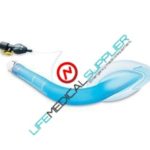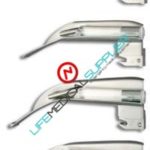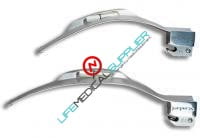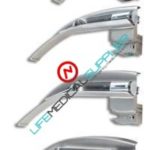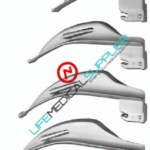No products in the cart.
Return To Shop
Log in / Sign in
Login
Register
Log in / Sign in
Login
Register
Flange-Less Mac Conventional laryngoscope blade Large Adult
Product Categories
Filter by price
Ambu Reusable Laryngeal mask curved
$188.90
[Features]The Ambu® Aura40™ is the world's first reusable laryngeal mask to feature a built-in curve that carefully replicates natural human anatomy. This curve is molded directly into the tube so correct insertion is easy without abrading the upper airway.
Our unique curve also ensures that the patient's head remains in a more natural position when the mask is in use without extra stress on the upper jaw. Moreover, Aura40 is specially designed to give the airway tube the flexibility needed to adapt to individual anatomical variances and a wide range of head positions.Aura40 also features a reinforced tip, which helps prevent folds during insertion that can cause improper positioning and possible airway leak. Convenient depth marks provide a visual indication of the mask position and the flat underside of the tube makes it easier to grip. In short, positioning is fast and accurate, each and every time.Key Features:
- Built-in, anatomically correct curve for easy insertion
- Reinforced tip will not bend during insertion so placement is always correct
- Cuff and airway tube molded as single unit for extra safety
- Extra soft cuff ensures the best possible seal with least possible internal pressure
- Ergonomically shaped for firm grip during insertion
- Inflation line is firmly affixed to aay tube for 3-6 cm to prevent tangles
- Color-coded pilot balloon identifies mask size and provides precise tactile indication of degree of inflation
- Universal check valve
- Convenient depth marks
- Eight convenient sizes from #1 to #6
Select optionsFiber optic Disposable MAC blade 20/Box
$152.90
ENGLISH IV MAC This design provides the extended viewing channel for users who prefer an extended flange in the MacIntosh blade. The channel may also be used as a guide to insert an endotracheal tube.
Select optionsFiber Optic GreenLine® PrismView™ laryngoscope Blades
This product has been discontinued.
GreenLine® PrismView™ Blades - AMERICAN PROFILEThe English PrismView and American PrismView blade may be used:• When the view of the vocal cords is impaired, especially the most anterior larynx
• During nasal intubation
• For post operative examination of the larynx Both contain an optically polished prism which provides a refraction of 30° without image inversion. To prevent condensation, warm the prism before use by immersing the entire blade in warm water.
Read moreFlange-Less MAC laryngoscope Blade Adult
$38.88
FLANGE-LESS MAC (BIZZARRI-GIUFFRIDA) A modification of the MacIntosh blade with the upper flange removed. This blade is especially well suited for use in patients with a limited mouth opening, prominent incisors, receding mandible, short thick neck, or having the larynx in an extreme anterior anatomical position. The absence of the flange greatly reduces the chance of trauma during laryngoscopy. Blade is made of surgical stainless steel.
Select optionsFO laryngoscope blade MAC “G” Profile
$78.45
“G” PROFILE MACINTOSH BLADEBuilt with an integral, extra large fiber optic bundle providing more cool, white light. Integral design enables superior cleaning by elimination of cracks and crevices.• Integral fiber optic bundle• 303/304 surgical stainless steel• No cracks, crevices to trap debris, helps to prevent cross contamination• Cleaning/Sterilization: No adverse affect in using ETO, steam autoclaving, or by soaking in Sporax or Cidex.• Long life• Large fiber optic bundle offers more light• Not chrome plated
Select optionsGreenLine® Miller “G” Profile laryngoscope Blade #0
$78.45
MILLER BLADE “G” PROFILE
Built with a integral fiber optic bundle providing more cool, white light. Integral design enables superior cleaning by elimination of cracks and crevices.
• Integral fiber optic bundle• 303/304 surgical stainless steel• No cracks, crevices to trap debris, helps to prevent cross contamination• Cleaning/Sterilization: No adverse affect in using ETO, steam autoclaving, or by soaking in Sporax or Cidex.• Large fiber optic bundle offers more light• Not chrome plated
Select optionsGreenLine® PrismView™ English Profile MacInstoch Blade
$110.48
GreenLine® PrismView™ Blades - ENGLISH PROFILEThe English PrismView and American PrismView blade may be used:• When the view of the vocal cords is impaired, especially the most anterior larynx
• During nasal intubation
• For post operative examination of the larynx Both contain an optically polished prism which provides a refraction of 30° without image inversion. To prevent condensation, warm the prism before use by immersing the entire blade in warm water.
Select optionsGreenLine® Reduced Flange E-MAC laryngoscope Blade
$65.15
MacIntosh Blades - Improved VisionMACINTOSH REDUCED FLANGE BLADEPatented modification to the “English” profile laryngoscope blade. Reducing the flange will enable the user to exert less force upon the maxillary incisors. A channel has been created which adds strength to the blade. This provides a channel through which an endotracheal tube may be inserted after visualizing the cords.
Select optionsGreenLine® Wis-Hipple laryngoscope Blade
$52.19
WIS-HIPPLEModification of the Wisconsin blade with a circular flange. Compared to the Wisconsin or Wis-Foregger blade, the flange tends to be straighter and run parallel with the spatula. This blade was designed primarily for use in infants. The tip, or beak, of the Wis-Hipple is wider and well adapted in lifting the epiglottis.
Select optionsGreenLine®/D™ Miller Disp. laryngoscope Blade 20/Box
$122.99
Laryngoscopes - Fiber Optic IlluminationGreenLine®/D™ MillerStainless Steel, Sterile, Disposable Fiber Optic BladesPatent # US 7,128,710 B1The GreenLine®/D™ disposable laryngoscope blades solve contamination problems and eliminate the cost and time spent cleaning laryngoscope blades and returning them for use.
Size 1 Infant- Answers the professional’s request for a non-plastic disposable and suitable for everyday hospital use
- Polished acrylic stem produces exceptional illumination
- Used with any reusable “Green System” fiber optic handle. Compatible with: AMS, Anesthesia Associates, Heine, Propper, Rusch, and Welch Allyn
Select optionsGuedel laryngoscope Blade
This product has been discontinued.
GUEDEL - ENGLISH PROFILE The Guedel blade is another original straight blade that has been modified by angling the blade 28° on its base toward the handle. This helps to promote lifting without the teeth as a fulcrum. The Guedel blade was one of the first blades designed specifically for use with cuffed endotracheal tubes. The distal tip has slightly more angulation than the Flagg to assist in compression of the epiglottis.
Select optionsMacintosh Blades English IV mac Improved Vision MAC
$55.25
MACINTOSH BLADE - IMPROVED VISIONSurgical stainless steel MacIntosh blades, designed to improve your view of the vocal cords.ENGLISH IV MACThis design provides the extended viewing channel for users who prefer an extended flange in the MacIntosh blade. The channel may also be used as a guide to insert an endotracheal tube.
Select optionsCategories
- Airway Management Devices
- Airway Intubation Bags
- CO2 Detectors - E.I.D.
- Combitubes - Esophageal Tracheal Airway
- Cricothyrotomy kits
- Endotracheal tubes
- Fiber Optic Laryngoscope Kits
- Fiber Optic MacIntosh Blades
- Fiber Optic Miller Blades
- Guedel & Berman oral Airways
- Intubation Aids
- Intubation kits
- Laryngeal Mask Airway, LMA, Supraglottic Airway
- Laryngoscope Handles
- MacIntosh Conventional blades
- Miller Conventional Blades
- Nasopharyngeal Airways NPA
- Standard Laryngoscope Sets
- Ambulance Accessories
- Aspirators - Suction Equipment
- Burn management - Wound care
- CPR training - manikins
- Emergency medical bags
- Emergency Response
- Immobilization & Extrication
- Cardboard Splints
- Cervical Collars
- CPR Boards
- Emergency Backboards, Spineboards, medical backboards
- Extrication Rescue equipment
- Folding Emergency backboards
- Head immobilizers
- Patient Restraint Straps
- Pediatric Immobilization
- Prosplints - Air Splints - Sam splints
- Rescue Transfer Sheets
- Spider straps
- Traction splints
- Trauma Air Pants - Anti-shock Trousers
- Vacuum Splints
- Medical Equipment - Accessories
- Military Emergency medical Zone
- Oxygen equipment & supplies
- Air compressors
- Cylinders, Accessories and parts
- Emergency Oxygen kits
- Humidifiers and Nebulizers
- Medical Air regulators
- Medical gas adapters & Fittings
- Medical gas wall outlets
- MRI oxygen equipment
- Multilators - Minilators - Selector Valves
- Nitrous Oxide regulators
- O2 mask, nasal cannulas
- Oxygen cylinder bags
- Oxygen Cylinders, tanks
- Oxygen Flowmeters
- Oxygen regulators CGA540 Valve
- Oxygen regulators CGA870
- Pediatric Low Flow oxygen regulators
- Preset oxygen regulators 50psi
- Patient transport & Accessories
- Resuscitation equipment
- Allied Healthcare Mass Casualty Ventilators
- Autovent Automatic Transport Ventilators
- Autovent circuits, filters & hoses
- CPR Masks - Rescue barriers - Faceshields
- Demand Resuscitator valves
- Disposable Manual resuscitators
- LSP EMT Resuscitators
- PEEP Valves
- Portable resuscitation systems
- Resuscitation masks - reusable
- Reusable BVM resuscitators
- Uncategorized
- Water Rescue Equipment/training
- Wound care

